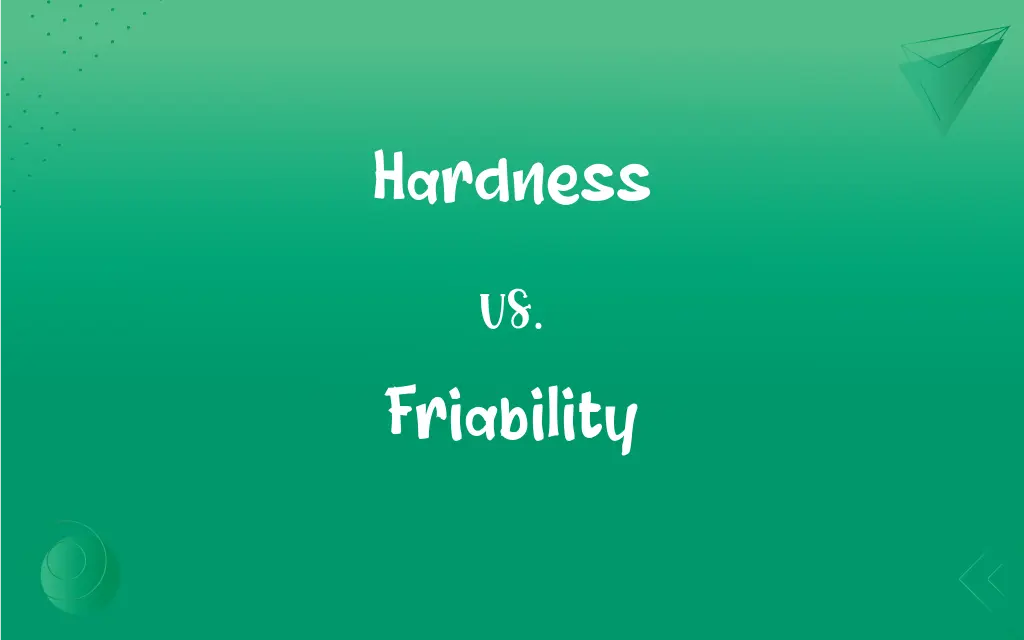Hardness vs. Friability: What's the Difference?
Edited by Aimie Carlson || By Janet White || Published on January 12, 2024
Hardness measures a material's resistance to deformation, while friability describes how easily a material crumbles or breaks apart.

Key Differences
Hardness is a property of materials that indicates their resistance to being scratched, indented, or deformed under pressure. It is a measure of a material's durability and strength. Friability, on the other hand, refers to the ease with which a material can be crumbled, pulverized, or reduced to powder, often indicating a lack of cohesion within the material.
The testing for hardness often involves methods like the Mohs scale for minerals, which assesses resistance to scratching. This property is crucial in applications where wear resistance is important. Friability, in contrast, is assessed by how readily a material disintegrates, which is particularly significant in fields like pharmaceuticals, where tablet durability is a concern.
Hardness is a critical property in materials such as metals, ceramics, and certain polymers, often correlating with tensile strength and resistance to wear and tear. Friability is a term more commonly used in reference to softer materials or composites, where the binding of the particles is weak, leading to easy disintegration.
A high degree of hardness generally implies that a material can withstand substantial force or stress without alteration in shape or form. Conversely, a high degree of friability indicates a material's tendency to break down under minimal stress, often being a desirable property in specific applications like manufacturing of certain food products or pharmaceuticals.
Hardness is a measure of a material's resistance to change under physical stress, friability measures the propensity of a material to break apart or disintegrate under similar conditions. Both properties play crucial roles in determining the appropriate use and handling of various materials.
ADVERTISEMENT
Comparison Chart
Definition
Resistance to deformation or scratching.
Ease of crumbling or breaking apart.
Measured By
Methods like the Mohs scale.
Assessments of disintegration under stress.
Relevant Materials
Metals, ceramics, hard polymers.
Soft materials, loosely bound composites.
Indicates
Durability and wear resistance.
Lack of cohesion and ease of disintegration.
Importance in Industry
Crucial in construction, manufacturing.
Significant in pharmaceuticals, food production.
ADVERTISEMENT
Hardness and Friability Definitions
Hardness
It measures how well a material can withstand physical force.
The hardness of steel makes it ideal for constructing durable machinery.
Friability
It measures a material’s tendency to crumble or disintegrate.
The high friability of certain tablets allows them to dissolve quickly in water.
Hardness
Hardness reflects a material's ability to resist deformation.
Hardwood floors exhibit high hardness, resisting dents and scratches.
Friability
Friability refers to how easily a material breaks into smaller pieces.
The friability of chalk makes it break easily when pressure is applied.
Hardness
Hardness is the resistance of a material to scratching or indentation.
The hardness of diamond allows it to cut through glass easily.
Friability
It is a critical property for materials intended to break apart easily.
The friability of a cookie is key to its texture and eating experience.
Hardness
It is a material's capacity to resist wear and abrasion.
The hardness of a tool's blade determines its longevity in cutting tasks.
Friability
Friability indicates the lack of cohesion within a material.
Soil's friability is important for determining its suitability for agriculture.
Hardness
Hardness quantifies the strength of a material's surface.
Measuring the hardness of minerals helps in identifying them accurately.
Friability
Friability assesses how a material reacts under minimal stress.
The friability of compressed powders is tested to ensure quality in manufacturing.
Hardness
The quality or condition of being hard.
Friability
Readily crumbled; brittle
Friable asbestos insulation.
Hardness
The relative resistance of a mineral to scratching, as measured by the Mohs scale.
Friability
The quality of being friable, or easily broken, crumbled, or reduced to powder; friableness.
Friability
Excessive breakableness
FAQs
How does friability differ from hardness?
Friability is about how easily a material crumbles or breaks apart, unlike hardness.
Why is hardness important in construction materials?
It ensures durability and longevity under stress.
What is hardness in materials?
Resistance to scratching, indentation, and deformation.
Can a material be both hard and friable?
Rarely, as hardness and friability are usually inversely related.
How is soil friability relevant to farming?
It affects soil workability and plant growth.
How do you measure the hardness of a mineral?
Commonly by the Mohs scale of mineral hardness.
Can friability be controlled in manufacturing?
Yes, through material composition and processing techniques.
Why is friability important in food products?
It influences texture and consumer satisfaction.
What role does friability play in pharmaceuticals?
It affects how quickly a tablet disintegrates and releases its active ingredients.
Is hardness always desirable?
Not always; it depends on the application and required material properties.
What tests are used for friability?
Tablet friability testers in pharmaceuticals, for example.
What materials are known for high hardness?
Diamonds, certain steels, and ceramics.
Is hardness a factor in tool manufacturing?
Yes, it determines a tool's wear resistance and effectiveness.
What industries consider friability in their products?
Pharmaceuticals, food, and construction materials.
How do temperature changes impact hardness?
They can alter material properties, affecting hardness.
Does hardness affect a material's machinability?
Yes, harder materials are generally more challenging to machine.
How does moisture affect soil friability?
It can either improve or reduce friability, depending on soil type.
Can hardness change over time?
Yes, due to factors like wear, corrosion, or temperature.
Can friability be a measure of quality?
Yes, especially in products where controlled disintegration is key.
Is there a universal scale for measuring hardness?
There are several scales, like Mohs for minerals and Rockwell for metals.
About Author
Written by
Janet WhiteJanet White has been an esteemed writer and blogger for Difference Wiki. Holding a Master's degree in Science and Medical Journalism from the prestigious Boston University, she has consistently demonstrated her expertise and passion for her field. When she's not immersed in her work, Janet relishes her time exercising, delving into a good book, and cherishing moments with friends and family.
Edited by
Aimie CarlsonAimie Carlson, holding a master's degree in English literature, is a fervent English language enthusiast. She lends her writing talents to Difference Wiki, a prominent website that specializes in comparisons, offering readers insightful analyses that both captivate and inform.






































































